| Srl | Item |
| 1 |
ID:
077015
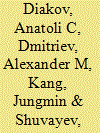

|
|
|
|
|
| Publication |
2007.
|
| Summary/Abstract |
A considerable amount of experience has been accumulated in converting compact research reactors from highly-enriched uranium (HEU) to low-enriched uranium (LEU). Although the details of naval-reactor design are closely held military secrets, during the Gorbachev period, the Soviet Union supplied the Norwegian government with some basic data, including the dimensions and 235U content of the core of the HEU fueled KLT-40 reactor used in some Russian nuclear-powered icebreakers. A group of Norwegian analysts used this information to develop a simple model of the KLT-40 core. We have calculated the neutronics behaviors of variants of these core models as a function of 235U burnup and conclude that the reactors could be fueled with LEU without loss of core life. We also show that simplified infinite-core calculations can be used for such studies
|
|
|
|
|
|
|
|
|
|
|
|
|
|
|
|
| 2 |
ID:
141685


|
|
|
|
|
| Summary/Abstract |
On August 27, the International Atomic Energy Agency (IAEA) and Kazakhstan signed an agreement establishing a fuel bank of low-enriched uranium (LEU).
|
|
|
|
|
|
|
|
|
|
|
|
|
|
|
|
| 3 |
ID:
082425
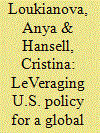

|
|
|
|
|
| Publication |
2008.
|
| Summary/Abstract |
.S. leadership has been the driving force behind reducing the civilian use of highly enriched uranium (HEU). By tracing the history of linkages between U.S. HEU policies at home and abroad, this paper examines the reasons why the U.S.-led Reduced Enrichment for Research and Test Reactors (RERTR) and HEU removal programs, despite great technical successes, have not led to quicker elimination of weapon-grade uranium. It argues that the United States must take urgent steps domestically and internationally in order to achieve global elimination of the use of HEU in the civilian sphere. Washington must restore consistency of HEU policy by rescinding the Burr Amendment and consider reductions in the U.S. military stockpile as a means of signaling its commitment. U.S. leaders must also find more creative ways to engage countries and individual facilities in HEU minimization and to extend the norm against HEU use worldwide
|
|
|
|
|
|
|
|
|
|
|
|
|
|
|
|
| 4 |
ID:
082426
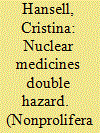

|
|
|
|
|
| Publication |
2008.
|
| Summary/Abstract |
This article examines the production of metastable technetium-99 (Tc-99m), the world's most important radiopharmaceutical, focusing on reliability of supply and risks of nuclear terrorism. Only four producers manufactured about 95 percent of the world's Tc-99m; a closure of any of them could cause worldwide shortfalls. Moreover, all four employ highly enriched uranium in their production process, in a form relatively easy to convert into the metal needed for a nuclear bomb. The technology to employ low-enriched uranium (LEU)-not usable in weapons-to produce Tc-99m is proven, available, and has been used by smaller producers. However, political determination and sufficient funding are needed to convert the major producers' isotope production to LEU and encourage new LEU-based production. Such efforts are needed to ensure supplies and reduce security risks.
|
|
|
|
|
|
|
|
|
|
|
|
|
|
|
|
| 5 |
ID:
082424
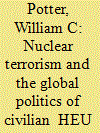

|
|
|
|
|
| Publication |
2008.
|
| Summary/Abstract |
An increasing number of countries recognize the special risks of nuclear terrorism associated with the civilian use and storage of and commerce in highly enriched uranium (HEU). They are especially concerned that non-state actors might gain access to HEU and use it to build and detonate improvised nuclear devices. The risk is aggravated by the very large global stocks of HEU, some of which are inadequately protected. Although HEU has few commercial uses, and most experts believe it is technically feasible to substitute low-enriched uranium for HEU in nearly all civilian applications, efforts to reduce HEU stocks have been impeded by a variety of economic, political, and strategic considerations. This article analyzes the nature of these impediments and discusses what is required to overcome them
|
|
|
|
|
|
|
|
|
|
|
|
|
|
|
|
| 6 |
ID:
149609
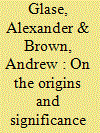

|
|
|
|
|
| Summary/Abstract |
The International Atomic Energy Agency (IAEA) defines uranium with a 235U isotope concentration of 20 percent as the threshold between low-enriched uranium (LEU) and highly enriched uranium (HEU), and as a significant waypoint on the path towards weapon-grade uranium (typically above 90 percent 235U enrichment). The distinction between LEU and HEU is widely used in shaping nonproliferation policy, and it has featured prominently in commentary over Iran's nuclear program and the series of Nuclear Security Summits that since 2010 have sought to minimize civilian stockpiles and use of HEU. Yet the origin of this threshold is obscure, dating back 6 decades. This research note traces the political origin and the technical basis for this limit.
|
|
|
|
|
|
|
|
|
|
|
|
|
|
|
|
| 7 |
ID:
082427
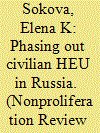

|
|
|
|
|
| Publication |
2008.
|
| Summary/Abstract |
Russia holds the largest stocks of civilian highly enriched uranium (HEU) of any country, operating more than fifty research reactors, pulsed reactors, and critical assemblies using HEU, as well as nine HEU-fueled icebreakers. Russia's participation in international efforts to phase out civilian HEU is crucial if international HEU minimization efforts are to succeed. Individual Russian institutes and organizations participate in international programs to replace HEU with low-enriched uranium in Soviet-supplied research reactors, develop alternative fuels, and repatriate fresh and spent HEU fuel from third countries. However, an overarching national policy on HEU phase-out has yet to be adopted. There are many obstacles to obtaining such a commitment from Moscow. At the same time, the ongoing reform of the Russian nuclear industry and plans for expansion of domestic nuclear power generation and for increased nuclear exports create opportunities for securing such a commitment
|
|
|
|
|
|
|
|
|
|
|
|
|
|
|
|
| 8 |
ID:
082430
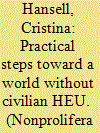

|
|
|
|
|
| Publication |
2008.
|
| Summary/Abstract |
In the last three decades, the Reduced Enrichment Research and Test Reactors program has made great progress in developing the technical means to eliminate HEU use in most civilian applications. Yet in practice, this has not translated into significant global reductions in HEU use. This article identifies steps to build the international consensus needed to reduce the risks posed by HEU. Immediate steps include devising new incentives for reactor shutdown and conversion; establishing research reactor coalitions; launching a global HEU database; giving the International Atomic Energy Agency a mandate to promote HEU minimization; and improving physical protection standards. Intermediate measures include the adoption of HEU management guidelines and a code of conduct. Further, national governments should pass laws phasing out domestic use of HEU and conditioning HEU exports on conversion commitments. In the long term, international legal measures must be adopted to eliminate the risks posed by HEU.
|
|
|
|
|
|
|
|
|
|
|
|
|
|
|
|